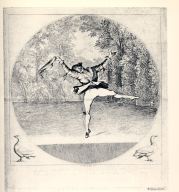 Men in the Ballet
Men in the Ballet
Charles Morrison's definition of nineteenth-century masculinity, with its denial of “everything showy and popular” and its extolment of a “closed” disposition, would hardly fall in line with the attributes of the danseur. This depiction of Auguste Vestris, one of the most famous male dancers of the late eighteenth century, is hardly the vision of restrained practicality and tentative manners. In his time (the date of this image is 1781), Vestris was seen to embody all the noble aspects of the courtly ballet and the masculinity admired and extolled by an affluent, aristocratic society. However, it is significant that Nathaniel Dance, who drew the image upon which this etching is based, was paid fifty guineas to depict Vestris in a light pink tunic and hat, to which Vestris responded by accusing the painter of libel.